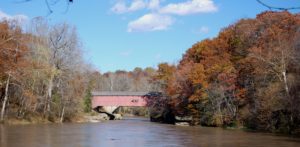
The lovely little stream christened Sugar Creek arises near the border of Clinton and Tipton Counties up in central Indiana. It then flows to the southwest for ninety miles, mostly at a leisurely clip with two or three miles an hour being the norm. Along the way there are short, faster stretches of white water that pass for rapids here in Indiana. I suppose someone who cut their kayaking-teeth on western streams would be less impressed and more likely to call them riffles. But they are sufficient to make the stream a popular one for canoeists and kayakers. As the stream follows its meandering path, a watershed of just over 800 square miles is drained. All this runoff from farmland and forest eventually joins the Wabash River just north of the little burg of Montezuma.
Sugar Creek has done some beautiful work in the ten thousand years since Indiana’s encounter with the Wisconsin ice sheet. The sandstone bluffs along its course testify to the steady, patient, erosive power of water. In places, the stream has cut through fossil-bearing strata of high quality. Much of this bedrock represents sediments from the bottom of an ancient inland sea. I once saw a wonderfully detailed (and expensive) slab of Indiana sandstone loaded with marine crinoid fossils (folks around here often call them Indian beads) in a shop in Jackson, Wyoming. Noting its source, I was pleasantly surprised to see Crawfordsville, Indiana listed.
I’ve made a few trips down Sugar Creek by canoe, but it’s been awhile; a good long while now that I think about it. Perhaps being 72 years old has something to do with this recent dearth of Sugar Creek canoeing. I’ll admit that sitting in the same position on an aluminum seat for several hours has lost much of its charm. Being a little less flexible in the joints doesn’t improve one’s canoeing skills either. Additionally, there is that pesky issue of possessing a sense of balance that now seems to unpredictably hit “pause” of its own volition
But, I certainly wouldn’t think of telling you not to do a float on Sugar Creek some summer. The stream still has much to offer. Usually low and in no particular hurry in midsummer (in fact you might do some portaging), Sugar Creek winds its way through both Shades and Turkey Run state parks, two of the state’s last natural gemstones. Indiana’s first nature preserve, Pine Hills, also lies along Sugar Creek. The huge sycamores, one of Indiana’s largest trees, lining the stream are a sight to behold. Beyond the sycamores, and cloaking the slopes above the creek, stand rich forests of oak, maple, and hickory. The numerous sand and gravel bars are inhabited by soft-shelled turtles. Espying your approach, they race down the sand bar and into the water at a speed that makes a lie of the old saw about turtles moving in slow motion. Great blue herons prowl the shoreline. Their stately, patient stalking of prey is a reminder for us to be persistent, stick with a task and we will be rewarded. Turkey vultures in decorous, soaring flight can be seen passing overhead in the narrow aperture betwixt the forested canopies of the left and right banks. Keep a wary eye lest your presence surprises them and a cascade of defensive vomit comes plummeting from on high. Pileated woodpeckers traverse the stream in their determined search for a delicious meal of carpenter ants or wood-boring beetle larvae. Belted kingfishers stand guard upon dead snags, ready to plunge dive for shiners or young suckers. Today there is a good chance of seeing a bald eagle. Back in my canoeing days, seeing a bald eagle was a very rare event. They were still recovering from the ravages of DDT. Yes, there is much to see and appreciate along Sugar Creek.
Speaking for myself, it isn’t so much the physical challenge that has kept me away all these years. The problem is that I am old enough to recall another era on the stream; one that is gone now and unlikely to return. Five decades ago – yes, I guess it really has been that long – one could float Sugar Creek from Crawfordsville down to Jackson Bridge in Parke County and still get a sense of 19th century Indiana. One could capture the sensation of adventure engendered by being a pioneer, a discoverer, an explorer. Of course the reason for the distinct difference between then and now was the lack of other people on the water. Just west of Crawfordsville itself one was prone to see cabins and fish-camps, but their numbers soon diminished and the stream was mostly deserted. On one of my trips back in the sixties, we encountered only two other canoes during two days of travel. Most of the time It took little effort to be transported back in history and to imagine that you were the only one on the stream altogether. Perhaps it is inevitable that all this has changed now. Canoes, with their novice pilots and noisy passengers are deposited by the busload at the drop-off points. The sense of solitude and independence that was so much a part of the Sugar Creek experience is gone for good. No amount of effort will allow one to imagine being alone with the stream or engaged in your own musings while drifting along within a veritable flotilla.
Upon reflection, perhaps I am being selfish. After all, one could argue that Sugar Creek is a natural resource that should be available to all who seek to enjoy its scenery and biodiversity. And admittedly the state has been unusually progressive in trying to protect this lovely piece of Indiana natural history. In 2010, a partnership of conservations groups, state government, and landowners launched the Healthy Rivers initiative which is meant to protect over 40 000 acres of land along Sugar Creek and the Wabash River. From Shades State Park down to Fairbanks Landing Fish and Wildlife Area, over ninety miles of aquatic habitat and adjacent land is to be protected and conserved. It is a lofty and admirable goal in this age of economic growth, consumption at any cost, and political indifference (or is it hostility) toward our environments.
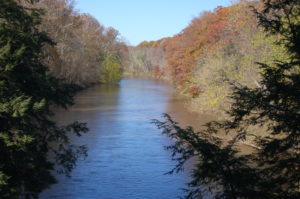
I admire the intent and labor put into the enactment of the Healthy Rivers Initiative. I must remind myself that, when I last floated Sugar Creek, there were five million people in Indiana. Now there are close to seven million. During this same period, the human population of the U.S increased by over one hundred and twenty million souls. Reason tells me that all these new citizens need a place to recreate. I cannot begrudge them this desire, this right, and perhaps someday I will again find myself upon the clear, turbulent waters of Sugar Creek. But I am daunted. Always lurking in my mind is the lament so common among those who have gained the boon of growing older, “If only it was like it was when I was young.”
And so today, when I think of Sugar Creek or encounter the stream from somewhere along its embankments, I automatically recall a certain, long-ago trip down the brook. This trip lies resting in my memory like a precious gem. Brought to the surface, this remembrance continues to constitute my vision of what Sugar Creek was and is.
It was my friend Jim with whom I shared the adventure in question.  Jim is gone now. I think about him often and his absence makes my world a lonelier and less interesting place. Jim was an artist whose bright mind roamed the gamut of human endeavors. Music, art itself, science, politics, literature and film; all these fell within his expansive sphere of interests. He could engage in an informed discourse on any of them. He was a man of mercurial temperament who suffered fools poorly. Jim had little tolerance for those who failed to meet the high standards of his broad-minded world view. He could be as explosive as a fumbled vial of nitroglycerine and was especially prone to direct his wrath toward inflexible, narrow minded religious dogma and its attendant intolerance. Politicians were another favored target of his wrath. Woe unto any public servants who traded in the goods which were anathema to Jim – hypocrisy, prejudices, disdain for the environment. His energetic, agile mind – which was prone to roam in unorthodox and inventive directions – was a constant stimulant prompting me in turn to seek, question, and consider. It was wonderfully entertaining to be around him. Jim, in his later years, described himself as an Alchemical Artist. I had always perceived this ancient science as merely a search for the skill of transforming lead into gold, a narcissistic pathway to wealth. But Jim’s exploration and comprehension of alchemy ran much deeper. He described alchemy to me as “. . . a complex and mysterious philosophy which involved a transformation process that sought spiritual renewal and an understanding of both the composition of the universe and how it worked.” A search for theology from a friend who decried organized religion? A quest in the realm of cosmology from one trained in art? Alchemy as the pursuit of spiritual and intellectual gold? These apparent contradictions made me even more aware of the depth of Jim’s interests, astuteness, and beliefs. In light of this, I was intrigued when I ran across author Edward Abbey’s reference to alchemy in describing a close friend of his own, the artist John De Puy . In reference to Du Puy’s brilliance, accompanied by a steady, purposeful intake of strong drink, Abbey said, “I suspected more than alcohol at work here. But the drug, as I would eventually understand, was not chemical but alchemical: the alkaloids of genius.” The alkaloids of genius were surely present in James Loney as well. What more can I say? Jim was the most interesting, thought-provoking person I have ever known. His was the irreplaceable friendship of a lifetime.
Jim is gone now. I think about him often and his absence makes my world a lonelier and less interesting place. Jim was an artist whose bright mind roamed the gamut of human endeavors. Music, art itself, science, politics, literature and film; all these fell within his expansive sphere of interests. He could engage in an informed discourse on any of them. He was a man of mercurial temperament who suffered fools poorly. Jim had little tolerance for those who failed to meet the high standards of his broad-minded world view. He could be as explosive as a fumbled vial of nitroglycerine and was especially prone to direct his wrath toward inflexible, narrow minded religious dogma and its attendant intolerance. Politicians were another favored target of his wrath. Woe unto any public servants who traded in the goods which were anathema to Jim – hypocrisy, prejudices, disdain for the environment. His energetic, agile mind – which was prone to roam in unorthodox and inventive directions – was a constant stimulant prompting me in turn to seek, question, and consider. It was wonderfully entertaining to be around him. Jim, in his later years, described himself as an Alchemical Artist. I had always perceived this ancient science as merely a search for the skill of transforming lead into gold, a narcissistic pathway to wealth. But Jim’s exploration and comprehension of alchemy ran much deeper. He described alchemy to me as “. . . a complex and mysterious philosophy which involved a transformation process that sought spiritual renewal and an understanding of both the composition of the universe and how it worked.” A search for theology from a friend who decried organized religion? A quest in the realm of cosmology from one trained in art? Alchemy as the pursuit of spiritual and intellectual gold? These apparent contradictions made me even more aware of the depth of Jim’s interests, astuteness, and beliefs. In light of this, I was intrigued when I ran across author Edward Abbey’s reference to alchemy in describing a close friend of his own, the artist John De Puy . In reference to Du Puy’s brilliance, accompanied by a steady, purposeful intake of strong drink, Abbey said, “I suspected more than alcohol at work here. But the drug, as I would eventually understand, was not chemical but alchemical: the alkaloids of genius.” The alkaloids of genius were surely present in James Loney as well. What more can I say? Jim was the most interesting, thought-provoking person I have ever known. His was the irreplaceable friendship of a lifetime.
And so, one summer, we had decided that just the two of us would float Sugar Creek. Previous trips had, for the most part, found us drifting among other companions. But this time Jim and I wanted to sense the quiet solitude and the open book of natural history that Sugar Creek represented without the discordance of other voices, other interests, other motives.
So we put in alone and carefully took our time. For the most part, we simply let the creek do the work and relaxed as it carried us along. We were fortunate on this trip and did find our solitude. We shared the natural beauty offered along the stream as we passed beneath the towering sycamores and cottonwoods, caught fleeting glimpses of downy and red-bellied woodpeckers in the fringing forest, and anticipated what new sight would greet us around the next bend.
As we moved along we fished. Happily, Sugar Creek has maintained an impressive diversity of fishes within its waters. An impressive variety of smaller species reside there: spotfin shiner, stoneroller, redhorse, silverjaw minnow, emerald shiner, and the beautiful rainbow darter.  Game fishes are present too. Catfish, bass, bluegill, and crappie swim the waters of Sugar Creek. The stream is considered by many to be the best fishing area for smallmouth bass in the state. Admittedly the fishing Jim and I did was accomplished in a casual sort of way. There were many other subjects of which to speak, other curiosities to consider. We made periodic casts but often simply let the night-crawlers on their harnesses troll along beside the canoe. It seems strange to me, after the passage of so many years, that the strike of the first fish remains so vivid in my memory. The deep pool cutting against the bank as the stream made its bend, the angle and intensity of the sunlight, the excited yells, and the agitated efforts we made to get the canoe turned and stopped, all are as fresh in my mind now as when I saw the tip of my rod whip toward the water’s surface. We did manage to get pulled onto the sandbar on the inside of the bend. We sat there and cast into the small, swift running pool (it couldn’t have been more than ten yards long) and time after time were rewarded. It seemed that every smallmouth bass and channel cat in this stretch of Sugar Creek had taken refuge in this one little spot. What a wonderful time we had.
Game fishes are present too. Catfish, bass, bluegill, and crappie swim the waters of Sugar Creek. The stream is considered by many to be the best fishing area for smallmouth bass in the state. Admittedly the fishing Jim and I did was accomplished in a casual sort of way. There were many other subjects of which to speak, other curiosities to consider. We made periodic casts but often simply let the night-crawlers on their harnesses troll along beside the canoe. It seems strange to me, after the passage of so many years, that the strike of the first fish remains so vivid in my memory. The deep pool cutting against the bank as the stream made its bend, the angle and intensity of the sunlight, the excited yells, and the agitated efforts we made to get the canoe turned and stopped, all are as fresh in my mind now as when I saw the tip of my rod whip toward the water’s surface. We did manage to get pulled onto the sandbar on the inside of the bend. We sat there and cast into the small, swift running pool (it couldn’t have been more than ten yards long) and time after time were rewarded. It seemed that every smallmouth bass and channel cat in this stretch of Sugar Creek had taken refuge in this one little spot. What a wonderful time we had. 
It has puzzled me greatly through the years as to why this particular episode has stayed with me in such a lucid way. The number of fish caught wasn’t great, maybe a half dozen of each. The size of none challenged the state record book. As I have mulled this over, it has become obvious to me that it wasn’t really the number or the size of the fish that mattered at all. It was the opportunity to fish. The chance to be with a good friend, to share a rare jewel of a day, to match skill against companion and fish alike; these are the things that have implanted the trip so deeply in my mind.
I like to come back to this memory now and again. It serves to remind me that some of the most important events in one’s life may be composed of the simplest ingredients – the companionship of a friend or loved one; a warm midday sun upon the shoulders; the fecund smell of earth and water and a simple excuse to delight in a Creation that endlessly fills us with awe and enchantment.
I hope you too have that friend of long-standing with whom you can share the natural world. Should you indeed be fortunate enough to have that special fishing pal, mushroom hunting buddy, birding comrade, or hiking companion consider it a blessing. Practice mindfulness. Be aware that you possess a prize of great value. Life is ephemeral. Deep, enduring friendships are rare treasures of immeasurable worth.
**********************************************************The Bald Eagle image is shown courtesy of James Romine.
Rainbow Darter image courtesy Iowa DNR: BioNet
Smallmouth Bass by Timothy Knepp, U.S. Fish and Wildlife Service [Public domain], via Wikimedia Commons

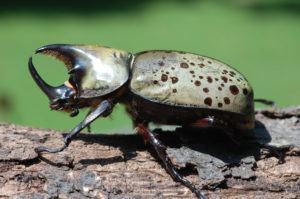 discovered a species of beetle that was previously unknown to science. Knowing whether or not one has a new species in hand requires expertise of course. Thus it is that one will find specialists in the taxonomy (identification and classification) of any particular group of organisms one wishes to choose. Some taxonomists go for the gold and tackle a group with charismatic star-power such as the dinosaurs. Others may, with forethought, choose a group of organisms in which taxonomic competition among biologists is less intense. Harvard entomology professor emeritus E.O. Wilson chose to become a myrmecologist (ant biologist) and in the process carved himself a niche within which he holds sway as the world’s acknowledged expert on this group. Some biologists will opt for an even more arcane group. This almost certainly guarantees them supremacy of expertise in their chosen area.
discovered a species of beetle that was previously unknown to science. Knowing whether or not one has a new species in hand requires expertise of course. Thus it is that one will find specialists in the taxonomy (identification and classification) of any particular group of organisms one wishes to choose. Some taxonomists go for the gold and tackle a group with charismatic star-power such as the dinosaurs. Others may, with forethought, choose a group of organisms in which taxonomic competition among biologists is less intense. Harvard entomology professor emeritus E.O. Wilson chose to become a myrmecologist (ant biologist) and in the process carved himself a niche within which he holds sway as the world’s acknowledged expert on this group. Some biologists will opt for an even more arcane group. This almost certainly guarantees them supremacy of expertise in their chosen area.  For example, when I was in graduate school, one of the professors in our department was an expert on the taxonomy of psocids. You may rightly ask, what in the world is a psocid? Many psocids look like tiny flies. Others, being wingless, resemble lice. Technically speaking, they belong to a group of insects known as booklice. They are quite small, one or two millimeters in length, and feed on lichens and fungi. Psocids often perch on shrubby vegetation. This particular professor could regularly be seen wandering about the campus with the tools of his trade – a black umbrella, a stout club, and an aspirator. Upon approaching a shrub, he would open the umbrella, hold it upside down under the vegetation, and suddenly begin flailing the branches with his club as though possessed by the sudden onset of some sort of mania. This frantic and, to outward appearance, bizarre routine would be met with open-mouthed astonishment by passersby. It really was quite entertaining to watch him at work. Of course, he was collecting psocids. Pummeling the shrubbery would cause any psocids present to fall onto the black umbrella. Here, despite their tiny size, the whitish body color would make them readily apparent. The aspirator was essentially a test tube with a stopper in it. From the stopper protruded two tubes. One was a short glass piece which the prof placed in his mouth. The other was a longer plastic tube which was positioned next to a psocid perched on the umbrella. A gentle suction applied to the glass tube resulted in the psocid being vacuumed into the test tube. A very interesting operation it was and one which made me admire the entertaining eccentricity of many scientists even more.
For example, when I was in graduate school, one of the professors in our department was an expert on the taxonomy of psocids. You may rightly ask, what in the world is a psocid? Many psocids look like tiny flies. Others, being wingless, resemble lice. Technically speaking, they belong to a group of insects known as booklice. They are quite small, one or two millimeters in length, and feed on lichens and fungi. Psocids often perch on shrubby vegetation. This particular professor could regularly be seen wandering about the campus with the tools of his trade – a black umbrella, a stout club, and an aspirator. Upon approaching a shrub, he would open the umbrella, hold it upside down under the vegetation, and suddenly begin flailing the branches with his club as though possessed by the sudden onset of some sort of mania. This frantic and, to outward appearance, bizarre routine would be met with open-mouthed astonishment by passersby. It really was quite entertaining to watch him at work. Of course, he was collecting psocids. Pummeling the shrubbery would cause any psocids present to fall onto the black umbrella. Here, despite their tiny size, the whitish body color would make them readily apparent. The aspirator was essentially a test tube with a stopper in it. From the stopper protruded two tubes. One was a short glass piece which the prof placed in his mouth. The other was a longer plastic tube which was positioned next to a psocid perched on the umbrella. A gentle suction applied to the glass tube resulted in the psocid being vacuumed into the test tube. A very interesting operation it was and one which made me admire the entertaining eccentricity of many scientists even more. The research station sat along the main trunk road which led from Kuala Lumpur, near the west coast, to the city of Kuantan lying hard by the South China Sea to the east. The facility was comprised of two buildings. One served as a laboratory where specimens collected during our forays into the rainforest could be identified, observed, and catalogued. The other building contained dormitories for the students, two small private rooms for staff, and a kitchen where the three meals students and staff took each day were prepared. In front of the dormitory, a small but well-manicured lawn sloped downward toward the nearby forest edge and the Sungei Gombak which flowed just inside the wall of trees. Although called a river, this stream was only a few yards across. I suppose a world-class long-jumper could have cleared it in a single leap. Nevertheless, the stream’s constant, muffled roar was a pleasant addition to the symphony of rainforest sounds falling steadily upon one’s ear. The stream was also a fruitful site should one want to search for caecilian larvae or foam-nesting tree frogs.
The research station sat along the main trunk road which led from Kuala Lumpur, near the west coast, to the city of Kuantan lying hard by the South China Sea to the east. The facility was comprised of two buildings. One served as a laboratory where specimens collected during our forays into the rainforest could be identified, observed, and catalogued. The other building contained dormitories for the students, two small private rooms for staff, and a kitchen where the three meals students and staff took each day were prepared. In front of the dormitory, a small but well-manicured lawn sloped downward toward the nearby forest edge and the Sungei Gombak which flowed just inside the wall of trees. Although called a river, this stream was only a few yards across. I suppose a world-class long-jumper could have cleared it in a single leap. Nevertheless, the stream’s constant, muffled roar was a pleasant addition to the symphony of rainforest sounds falling steadily upon one’s ear. The stream was also a fruitful site should one want to search for caecilian larvae or foam-nesting tree frogs. company with the cheery Malay students. All the while we could gaze out onto the nearby mountains, their slopes cloaked with a thick covering of dipterocarp forest.
company with the cheery Malay students. All the while we could gaze out onto the nearby mountains, their slopes cloaked with a thick covering of dipterocarp forest. 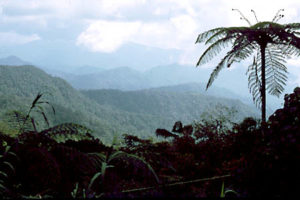 The superstars of this forest were the massive Shorea trees whose grayish- leaves caused them to stand out among the numberless greens of their brethren. Some of these Shorea were giants who towered over two-hundred feet above the forest floor. Occasionally a guttural call or a thrashing, leafy branch would alert us to the presence of a band of dusky or silvered leaf monkeys moving through the canopy. A flying lizard (Draco) might be seen soaring across the lawn its rapid, direct “flight” causing one to momentarily mistake it for a bird. On more than one occasion, the morning was embellished by a flyover of one of the rainforests largest birds, the rhinoceros hornbill. Occasionally the flight would be announced by the magnificent bird’s ringing, honking call. At other times the hornbill might pass above us without voice, its presence announced only by the deep, far-carrying sound from the beats of its five feet long wingspan.
The superstars of this forest were the massive Shorea trees whose grayish- leaves caused them to stand out among the numberless greens of their brethren. Some of these Shorea were giants who towered over two-hundred feet above the forest floor. Occasionally a guttural call or a thrashing, leafy branch would alert us to the presence of a band of dusky or silvered leaf monkeys moving through the canopy. A flying lizard (Draco) might be seen soaring across the lawn its rapid, direct “flight” causing one to momentarily mistake it for a bird. On more than one occasion, the morning was embellished by a flyover of one of the rainforests largest birds, the rhinoceros hornbill. Occasionally the flight would be announced by the magnificent bird’s ringing, honking call. At other times the hornbill might pass above us without voice, its presence announced only by the deep, far-carrying sound from the beats of its five feet long wingspan. 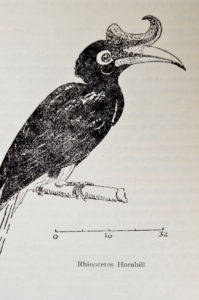 They reminded me of the chugging of a slow moving steam locomotive. Breakfasts were often graced by the exotic, high-pitched whooping of white-handed gibbons or the deep, booming voice of siamangs issuing from the far hills as they performed their morning routine of establishing territorial boundaries and maintaining the unity of their groups. Looking back I recall a magical place, a kind of Eden where I found myself joyous simply to be alive, euphoric over my good fortune in being present in one of planet earth’s last, great wild places.
They reminded me of the chugging of a slow moving steam locomotive. Breakfasts were often graced by the exotic, high-pitched whooping of white-handed gibbons or the deep, booming voice of siamangs issuing from the far hills as they performed their morning routine of establishing territorial boundaries and maintaining the unity of their groups. Looking back I recall a magical place, a kind of Eden where I found myself joyous simply to be alive, euphoric over my good fortune in being present in one of planet earth’s last, great wild places.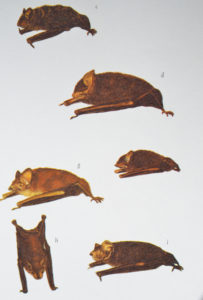
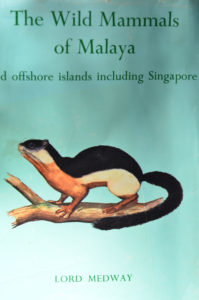 authoritative source of information on the mammals of Malaysia. Scanning through the tube-nosed bat descriptions, I found the closest match to be one with the common moniker of bronzed tube-nosed bat. It seemed pretty straight forward but, as I read the species description in Medway, I was startled. The text stated that not only was this bat known only from Malaysia, it was known from a single specimen taken in the neighboring state of Pahang. With rising pulse rate, I again ran through the measurements, observed the coloration, and referred to Medway’s description. I again came up with bronzed tube-nosed bat. Still not convinced that I hadn’t made an error in utilizing the taxonomic key, I ran through the characters a third time. Again the final couplet of the key led to Murina aenea, the bronzed tube-nosed bat.
authoritative source of information on the mammals of Malaysia. Scanning through the tube-nosed bat descriptions, I found the closest match to be one with the common moniker of bronzed tube-nosed bat. It seemed pretty straight forward but, as I read the species description in Medway, I was startled. The text stated that not only was this bat known only from Malaysia, it was known from a single specimen taken in the neighboring state of Pahang. With rising pulse rate, I again ran through the measurements, observed the coloration, and referred to Medway’s description. I again came up with bronzed tube-nosed bat. Still not convinced that I hadn’t made an error in utilizing the taxonomic key, I ran through the characters a third time. Again the final couplet of the key led to Murina aenea, the bronzed tube-nosed bat.